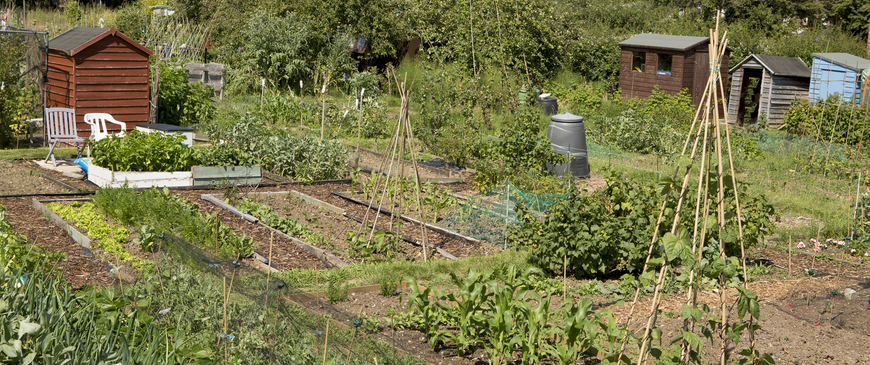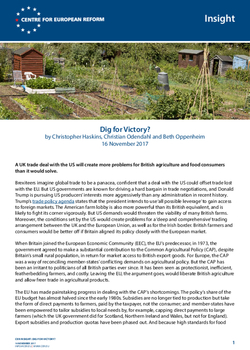
Dig for Victory?
A UK trade deal with the US will create more problems for British agriculture and food consumers than it would solve.
Brexiteers imagine global trade to be a panacea, confident that a deal with the US could offset trade lost with the EU. But US governments are known for driving a hard bargain in trade negotiations, and Donald Trump is pursuing US producers’ interests more aggressively than any administration in recent history. Trump’s trade policy agenda states that the president intends to use ‘all possible leverage’ to gain access to foreign markets. The American farm lobby is also more powerful than its British equivalent, and is likely to fight its corner vigorously. But US demands would threaten the viability of many British farms. Moreover, the conditions set by the US would create problems for a ‘deep and comprehensive’ trading arrangement between the UK and the European Union, as well as for the Irish border. British farmers and consumers would be better off if Britain aligned its policy closely with the European market.
When Britain joined the European Economic Community (EEC), the EU's predecessor, in 1973, the government agreed to make a substantial contribution to the Common Agricultural Policy (CAP), despite Britain's small rural population, in return for market access to British export goods. For Europe, the CAP was a way of reconciling member-states’ conflicting demands on agricultural policy. But the CAP has been an irritant to politicians of all British parties ever since. It has been seen as protectionist, inefficient, featherbedding farmers, and costly. Leaving the EU, the argument goes, would liberate British agriculture and allow freer trade in agricultural products.
A quick deal with the US, although politically expedient, could require undesirable concessions - at a high political price for the British government.
The EU has made painstaking progress in dealing with the CAP's shortcomings. The policy’s share of the EU budget has almost halved since the early 1980s. Subsidies are no longer tied to production but take the form of direct payments to farmers, paid by the taxpayer, not the consumer; and member-states have been empowered to tailor subsidies to local needs by, for example, capping direct payments to large farmers (which the UK government did for Scotland, Northern Ireland and Wales, but not for England). Export subsidies and production quotas have been phased out. And because high standards for food safety have been established across the Union, food flows freely across national borders without checks by customs officials, and consumers enjoy a huge range of food from across the continent.
But the EU remains protectionist in agriculture, with high EU import tariffs (the trade-weighted average tariff on agricultural products is 7.8 per cent, with some significantly higher, like dairy at 35.4 per cent). Farm subsidies still consume 38 per cent of the overall EU budget, which is disproportionally high, considering that gross value added in agriculture, forestry and fisheries combined is just 1.5 per cent of the EU total. Large landowners receive too much subsidy, mostly because many national governments choose not to implement caps on direct payments. Subsidies, even in the form of direct payments to farmers, lead to higher land prices and rents for landowners, who may or may not be the farmers themselves – benefits that are often compounded by generous tax treatment, for example in the UK. And the efforts to make European agriculture more environmentally friendly have not been as successful as hoped.
The UK imports 40 per cent of its food, and has a trade deficit with the EU in food: British exports were worth £18 billion in 2015, whilst imports were almost double, at £38.5 billion. If, as seems likely, Britain withdraws from the CAP, and leaves the single market and customs union, the country will need to establish alternative agreements to ensure a supply of affordable, safe, environmentally-sound food.
In a throwback to the ‘Dig for Victory’ campaign of the 1940s, Conservative transport minister Chris Grayling recently suggested that post-Brexit shortfalls in food could be met by ‘growing more’ in Britain. But the solution is more likely to come via trade. The question for Britain is whether agricultural trade with the US could offset the higher costs of trading with Europe in the case of no deal in agriculture.
There are several obstacles for UK trade minister Liam Fox. First, the American farm lobby is far more powerful than its British equivalent. Britain’s negotiating position is weak: its economy is one-sixth the size of the US, and it needs to strike trade deals quickly to offset the barriers the UK government has decided to erect with the EU. The UK finds itself out of practice in striking trade deals, having passed the mantle to the EU for the past 44 years. Given the asymmetry of bargaining power, US farmers would insist that a UK-US trade agreement engages with agriculture on their terms.
American regulatory standards allow cheaper food production, for example through genetically modified organisms and hormone-treated beef. Both practices are highly restricted in the EU. The US agricultural lobby has long considered some EU regulatory standards in agriculture as trade barriers to be ‘torn down’. In addition to production-friendly standards, the US’s favourable climate, cheaper land and larger farms give it a competitive edge.
Agricultural subsidies are another area where the US may seek advantage in trade talks. The US 2014 farm bill ended direct payments to farmers and introduced the 'agricultural risk coverage' scheme, where farmers buy crop insurance, subsidised by the government, at a cost of around $20 billion per year. Most US farm bill spending is on nutrition programmes, which are in effect welfare programmes for poorer households and indirectly benefit farmers. Moreover, many US states provide grants and subsidised loans to farmers. Much of the CAP, by contrast, is income support via direct payment. In trade negotiations with the UK, the US would demand a different support system for British farmers, to align it more closely with its own regime. It is unlikely that British agriculture would be able to compete with their American counterparts on such terms.
Furthermore, a comprehensive US-UK trade deal on agriculture would make a border-free Ireland and unfettered access to EU markets impossible after Brexit. If the UK adopted US standards to facilitate transatlantic trade, as US trade secretary Wilbur Ross recently demanded, it would diverge from EU regulations, such as food standards, sanitary and phytosanitary (SPS) measures and rules on the certification of food. Without EU standards and enforcement, there would have to be customs and sanitary checks at the EU’s border, even if tariffs could be avoided in a trade deal with the EU.
A comprehensive US-UK trade deal on agriculture would make a border-free Ireland and unfettered access to EU markets impossible after Brexit.
Such checks would have particular consequences for Ireland, as the flows of agri-food products between Ireland and the UK would be disrupted. The Irish agri-food sector is heavily dependent the UK, which imported 47 per cent of Irish agri-food products in 2015. The sector on the island of Ireland has established extensive supply chains, with some products crossing the Irish border multiple times. For example, a quarter of the milk produced in Northern Ireland is processed in the Republic.
Without knowing the precise trading arrangement, it is hard to be sure of the exact impact of Brexit, but the Irish Agriculture and Food Development Authority estimates that Irish agri-food exports would decline by between 1.4 to 8 per cent, with some exports being redirected to the rest of the EU. The only arrangement that would guarantee unrestricted trade on the island would be one in which Northern Ireland acquired a special status and remained in the customs union and with standards aligned with those of the EU, as recently suggested by both Brussels and Dublin. But such a status is strongly opposed by the Democratic Unionist Party (DUP), who make up Theresa May's fragile majority.
The absence of an EU trade deal would also have far-reaching implications for the whole UK. Trade with the EU would be on World Trade Organisation (WTO) terms. British exports to the EU would be hit by tariffs, with agri-food products worst affected. Such price hikes would reduce the competitiveness of UK products on the EU market, where most exports go (17 per cent go to the Republic of Ireland). Prices would also rise significantly on imports from Europe, which account for a third of British consumption, unless Britain unilaterally lowered tariffs: the Resolution Foundation estimates that dairy and meat products would become 8 and 6 per cent more expensive under WTO rules, hitting poorest households the most.
Geography presents another obstacle: the US market is 3,000 miles away. Distance matters for all trade, but affects trade in perishable goods the most. The proximity of the EU market for British farmers and consumers offers much greater potential for trade in food. The US is the UK’s second largest overall export market, and bought 19 per cent of British exports from 2016-17, whilst the EU bought 44 per cent. But food, feed and drink exports to the US are minimal, at less than 2 per cent, whereas the EU imports 62 per cent of UK agricultural exports. While this is also the result of high tariffs, the distant US market cannot be a full substitute for the much closer EU market; nor can Southern America or Australia and New Zealand.
Geography is an obstacle - the distant US market cannot be a full substitute for the much closer EU market.
The final obstacle is time. The Trump administration is preoccupied with renegotiating the North American Free Trade Agreement (NAFTA). Even in normal circumstances, the average US trade deal takes one and a half years to negotiate, and over three years to implement. The Transatlantic Trade and Investment Partnership (TTIP), the EU-US trade deal that is currently on hold, is far down the list; a UK-US trade deal is arguably even further down. A quick deal with the US, although politically expedient, would probably require undesirable concessions from the UK – concessions that would come at a high political price for the British government. Given the US’s insistence upon its standards and rules, a deal involving agriculture seems remote.
That leaves the UK with few options but to fully align with EU standards, observe EU state aid rules and hope for a trade deal that keeps tariffs at zero. As March 2019 is fast approaching, the UK would also need a transition agreement that covers agriculture to secure uninterrupted trade until a final trade arrangement is in place. Unfortunately, the off-the-shelf transition, the Norwegian/EEA solution, does not cover agriculture. Unless British officials make agriculture a priority in the transition talks, consumers and farmers in the UK will feel the brunt of Brexit pretty soon.
Lord Haskins is Chair, Humber Local Enterprise Partnership and former chairman, Northern Foods and Christian Odendahl is chief economist and Beth Oppenheim is a research assistant at the Centre for European Reform.


Comments
Add new comment